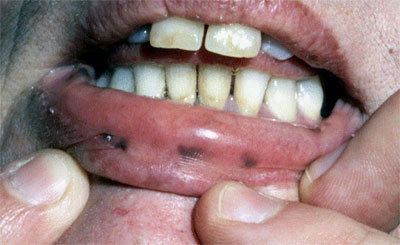|
|
|
Peutz-Jeghers syndrome
First described by Hutchinson in 1900, the association of cutaneous and mucosal hyperpigmentation with GI tract polyposis is now well known.
The polyps can be associated with duodenal carcinoma.
The pigmentary changes involve both the skin and mucous membrane.
The skin hyperpigmented macules usually are present at birth or early infancy, and frequently fade at puberty. They are typically grouped around the mouth, eyes and nostrils, with pigmented macules also located on the fingers, palms, toes, periumbilical skin, or diffuse over the skin surface.
Mucosal pigmented lesions are similar, but persist for life.
Buccal mucosal pigmented papillomas have also been described.
The malignant tumors are frequently associated with hamartomatous polyps.
The lifetime risk of a patient with Peutz-Jeghers syndrome developing an upper GI tract malignancy is in the order of 2-3%; the relative risk being 13. The relative risk of other, non GI tract cancers, is 9. Granulosa theca cell tumors may be present in as many as 20% of females with the Peutz-Jeghers syndrome, and may be associated with precocious puberty.
Peutz-Jeghers syndrome is inherited as an autosomal dominant condition.
Treatment:
- Regular upper GI tract endoscopy is recommended.

Back to Dermatology Glossary - P Index |
Back to Dermatology Glossary Index
|